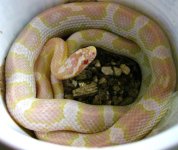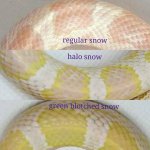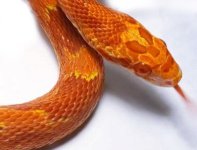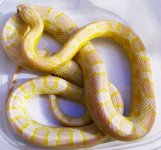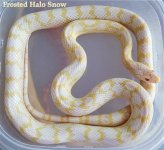scmartin27
capio cum grano salis
The title may be a little misleading. But I'll explain.
First: If you have not read my forum thread about HALO corn snakes, you may want to start there. Yes it's long, I'm sorry!
I'll summarize here so those who don't want to be fully educated can at least get the gist and offer some reasonable advice.
"Halo" is the term we've been using for the yellow borders that show up in many amel types. Most commonly snows - but I've also seen it in regular amels, fires, blizzards, lavamels, peppermints, scaleless amel types, and others (so far not lavender, however, which isn't surprising to me). I'll attach photos of some examples. The issue with testing this gene is that it is not visible in anything with melanin.
After doing a few trials I *believe* it to be dominant or incomplete dominant... with the possibility that Green Blotched (where the yellow completely covers the saddles, sometimes looking green) is the homozygous version if it is incomplete dominant.
Now on to the actual meat of the question: how do I test this with a WC? Though it may be dom/inc-dom, we can't see it in the F1s since they would all have full melanin. Breeding the offspring back together doesn't help our case either - all that would prove is that it can be passed on, but not specify if it is dom, inc-dom, or even recessive (which all signs point to it NOT being, so far).
So... any suggestions here? Again, before commenting with what you think should be done you may want to read my other post about Halos (http://www.cornsnakes.com/forums/showthread.php?t=145967). I've done many breeding trials already... but have been told by many that nothing is proven til it's bred straight to a WC. or something like that
Thanks for any input!
First: If you have not read my forum thread about HALO corn snakes, you may want to start there. Yes it's long, I'm sorry!
I'll summarize here so those who don't want to be fully educated can at least get the gist and offer some reasonable advice.
"Halo" is the term we've been using for the yellow borders that show up in many amel types. Most commonly snows - but I've also seen it in regular amels, fires, blizzards, lavamels, peppermints, scaleless amel types, and others (so far not lavender, however, which isn't surprising to me). I'll attach photos of some examples. The issue with testing this gene is that it is not visible in anything with melanin.
After doing a few trials I *believe* it to be dominant or incomplete dominant... with the possibility that Green Blotched (where the yellow completely covers the saddles, sometimes looking green) is the homozygous version if it is incomplete dominant.
Now on to the actual meat of the question: how do I test this with a WC? Though it may be dom/inc-dom, we can't see it in the F1s since they would all have full melanin. Breeding the offspring back together doesn't help our case either - all that would prove is that it can be passed on, but not specify if it is dom, inc-dom, or even recessive (which all signs point to it NOT being, so far).
So... any suggestions here? Again, before commenting with what you think should be done you may want to read my other post about Halos (http://www.cornsnakes.com/forums/showthread.php?t=145967). I've done many breeding trials already... but have been told by many that nothing is proven til it's bred straight to a WC. or something like that
Thanks for any input!

